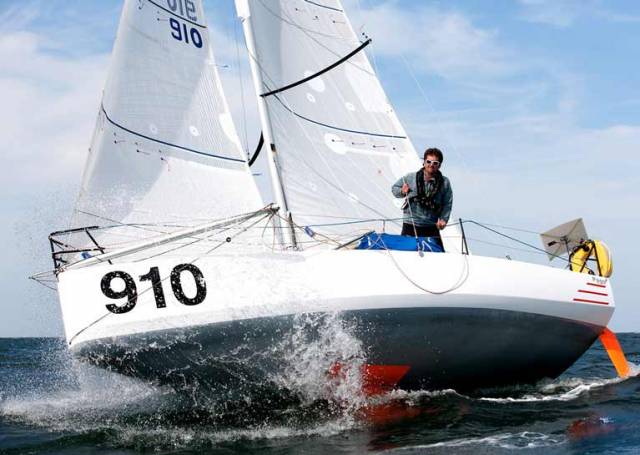In its forty years, the 4,000 mile Mini-Transat has become a very French event, despite always having a significant international presence which this time round will see Ireland’s Tom Dolan (30) in a leading role for 2017’s staging, starting tomorrow at La Rochelle on France’s Biscay Coast
The race’s full title is now La Mini Transat La Boulangerie, and it comes with the complete French-style sponsorship and full support circus. This includes a busy pre-event Race Village and a carnival atmosphere in the host town, where sponsors can get extra value from their backing of individual entries by having special access to facilitate their more privileged guests. W M Nixon tries to see it from the competitors’ angle.
It all started modestly enough in 1977, with the inaugural mini-Transat being staged by Penzance Sailing Club in far southwest England. An eccentric but very determined English ocean sailor called Bob Salmon reckoned long distance solo racing needed an affordable entry event.
His own offshore experience was to range from a variety of tiny craft to an early and well-worn Farr-designed 83ft Maxi, which was to race in the 1990 Round Ireland Race as Woodchester Challenger under Dickie Gomes’ command.
But meanwhile, back in 1977, just the once, Salmon persuaded Penzance SC to be the official body in running a two-stage Transatlantic Race with a stopover in the Canaries, the entry limited to boats so small that most folk would have thought themselves great achievers to have got as far as the Isles of Scilly in one of them.
Penzance may have been far from the seats of power in London and other European capitals. But in seagoing terms it puts you right beside the main highways of the eastern Atlantic. So in sending a fleet of solo-sailed mini-boats straight out from this distant Cornish port into a part of the ocean criss-crossed with shipping routes, the organisers were arguably contravening an entire raft of international maritime laws, and once it was over Penzance SC withdrew from future involvement.
But the French had been greatly interested from the start, so they took it over for 1979’s staging with a start from a French port, and set up the framework to convert it into a “special event”. This brought the makings of a support fleet to shepherd the little boats and their solo skippers across the Atlantic, and the arrival of a new line of development designs looking like overgrown Internatonal 14ft Dinghies, which pushed fresh limits in what you could do with hulls just 6.5 metres long.
 The early development of Mini-Transat designs as shown through the winners. They are (left to right) Petit Dauphine (1977), American Express (1979, Wylie design), Aquitaine (1985, Berret design), and GTM Enterprise (1991, Finot design).For the first race in 1977, the fleet had mostly been souped-up versions of standard French mini-offshore racers. These had been meeting the growing market inspired by Eric Tabarly’s leading of France towards its current maritime pre-eminence, with the Glenans training organization supplying a steady stream of able enthusiasts accustomed to making the best use of small craft. And sailing was also increasingly seen as something to be included in the French national school curriculum.
The early development of Mini-Transat designs as shown through the winners. They are (left to right) Petit Dauphine (1977), American Express (1979, Wylie design), Aquitaine (1985, Berret design), and GTM Enterprise (1991, Finot design).For the first race in 1977, the fleet had mostly been souped-up versions of standard French mini-offshore racers. These had been meeting the growing market inspired by Eric Tabarly’s leading of France towards its current maritime pre-eminence, with the Glenans training organization supplying a steady stream of able enthusiasts accustomed to making the best use of small craft. And sailing was also increasingly seen as something to be included in the French national school curriculum.
Back in 1977, there had been just one truly innovative boat, a special Caroffi-designed machine for Polish sailor Casimir Jarkowski, which emphasized downwind performance, for in that first race, the initial leg out to the Canary Islands was only a qualifying positioning event - the real race was the Transatlantic hop itself.
So Jarkowski’s boat had two big hanked-on headsails each with its own forestay, and carried no mainsail at all – everything was aimed at sailing fast in the supposedly favourable Trade Winds.
But by 1979 with the start now in France, things were becoming much more sophisticated, and the star of the prototype show that year – and the overall winner - was the Wylie-designed American Express, sailed by the quintessentially American Norton Smith. As mentioned, she was seen as an oversize take on the well-known International 14 dinghy, but to Irish eyes she looked, in profile at least, like an only slightly overgrown National 18 of the Crosshaven fleet of that era.
 American Express, overall winner in 1979. Beautifully built in multi-skin timber, she was reminiscent of a very slightly larger National 18 of that era.
American Express, overall winner in 1979. Beautifully built in multi-skin timber, she was reminiscent of a very slightly larger National 18 of that era.
Irish interest was soon there with Enda O’Coineen doing the race in the 1980s with his slightly-truncated Limbo 6.60 Kilcullen II, Kilcullen I having been the RIB in which he’d crossed the Atlantic west-east. Kilcullen II was dismasted while gybing with most of the race done, but the intrepid skipper lashed two spinnaker poles together to put up some sort of a rig, and with this he covered the last 550 miles in eight days – extremely good going in the circumstances – and after some permitted sculling to get to the finish line, he grabbed the outer limit buoy to show he was undoubtedly there.
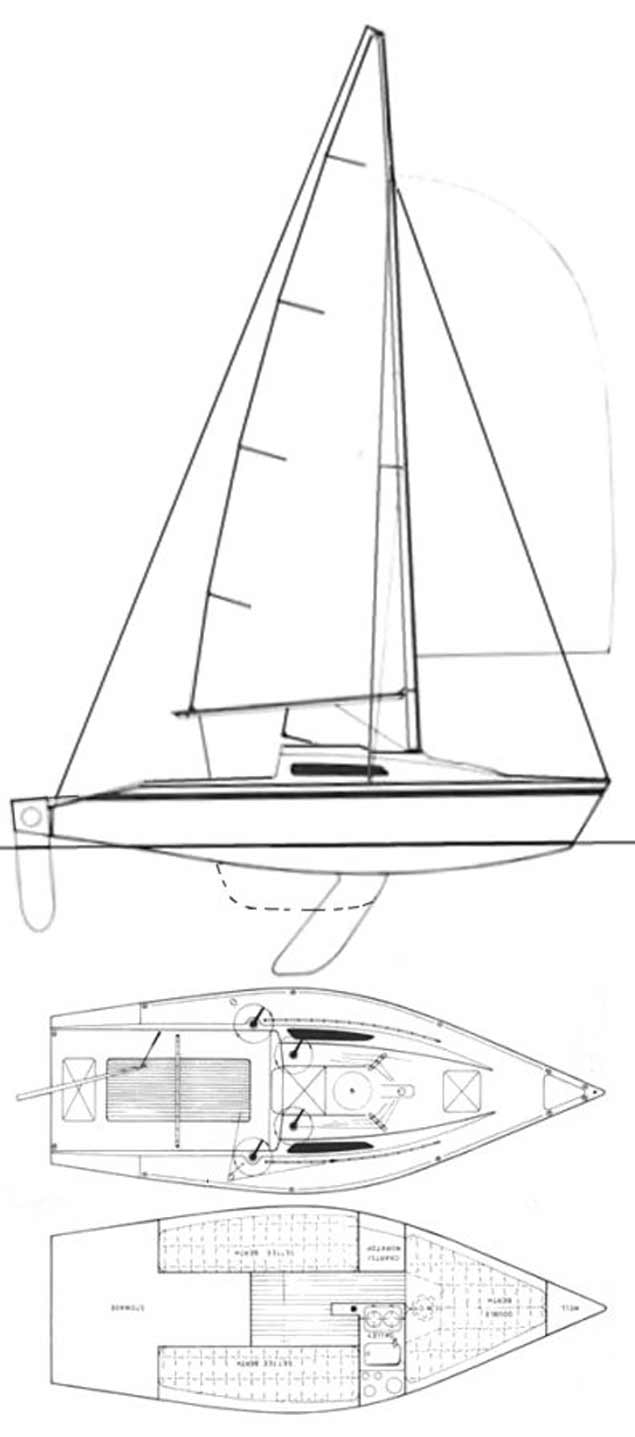 Enda O’Coineen’s Kilcullen II was a Limbo 6.60. Apart from needing to be shortened slightly, she was not an ideal boat even in the fleet of the 1980s, but she was available, and he got there with his usual determination despite being dismasted with 550 miles to go.
Enda O’Coineen’s Kilcullen II was a Limbo 6.60. Apart from needing to be shortened slightly, she was not an ideal boat even in the fleet of the 1980s, but she was available, and he got there with his usual determination despite being dismasted with 550 miles to go.
Legendary figures of extreme offshore racing have been through the Mini-Transat mill in its gateway guise, including another great American, Cam Lewis, whose latest venture is so at variance with general advanced Mini-Transat prototype thinking – which favours a scow configuration to maximum waterline body length – that we’re not at all sure what Lewis’s intentions are.
But this photo came up on the screen with so many things in it, including what we’re assured is a Cam Lewis boat, that we just have to publish it, while resisting the temptation to write a thousand words around the complete little universe illustrated in it. Nevertheless, apart from the crazy wedge-shaped boat, dontcha just love the doty little water-level garage beside the lighthouse keeper’s house?
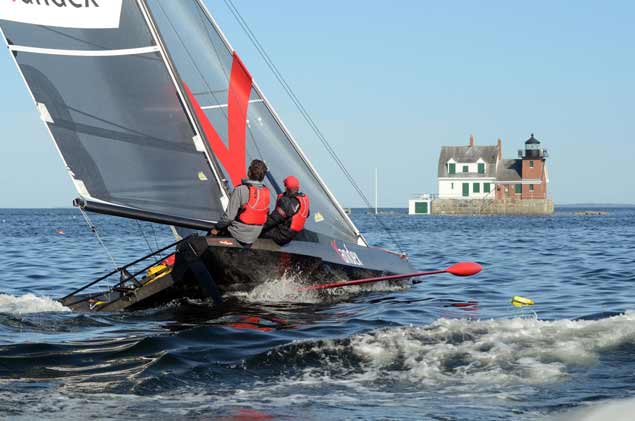 America’s Cam Lewis was another star of the Mini-Transat. We’re told this is one of his more recent projects (the boat, not the jaunty little lighthouse)
America’s Cam Lewis was another star of the Mini-Transat. We’re told this is one of his more recent projects (the boat, not the jaunty little lighthouse)
Meanwhile the latest experimental development for possible future use is in foiling. With a boat of Mini-Transat size, that makes for manageable cost at the R & D level. But this means “manageable” in relative terms. These days, the best entry-level boat to take on the production class is the Pogo 3 which Tom Dolan sails, and regular readers of Afloat.ie will be well aware of of the challenging route he has had to take to achieve his dream.
He squeezed together the money to buy a new but utterly basic unfinished version of the Pogo 3 at €70,000 - the “showroom” version is €130,000. He then spent hours, days and weeks on projects like bringing the keel finish up to scratch, generally finishing the boat, and working out sponsorship deals with electronic manufacturers and sailmakers and safety equipment providers to assemble the total package on a budget which sees him having to use far too much energy in seeking sponsorship deals, but that’s the way it goes.
It has been extra hard in that, although the French sailing press call him “l’Irlandais Volant” – The Flying Irishman - and rate his chances highly in the big race, despite the international interest it is essentially a Franco-centric event. Any commercial sponsorship which Tom secures, while it may have Irish links, has to have real relevance in France.
 Small boat, big ocean. This is where Tom Dolan wants to be
Small boat, big ocean. This is where Tom Dolan wants to be
Thus he has hit the button with a certain level of funding from Smurfit Kappa in Paris. But most of his other support is within France with a totally French orientation, for with the remarkable sense of community and special excitement which has grown up over the years around the Mini-Transat, commercial enterprises certainly want to be a part of it, but in a French context.
So it made for a real struggle for a farm boy from Meath, who arrived in France five years ago with barely a word of French, yet with a passion for sailing and a determination to build a realistc campaign towards the Mini-Transat, with other even bigger events in mind beyond that.
The reality is that if you were doing this from a standing start, buying a race-ready new Pogo 3 and doing the full 20-month buildup campaign after the previous 2015 Mini-Transat (in which Tom came 22nd in a loaned Pogo 2), then you’re looking at an overall budget of at least a quarter of a million euros and probably more if you want to keep your solo sailor clear of financial worries, and free to concentrate on improving his or her performance.
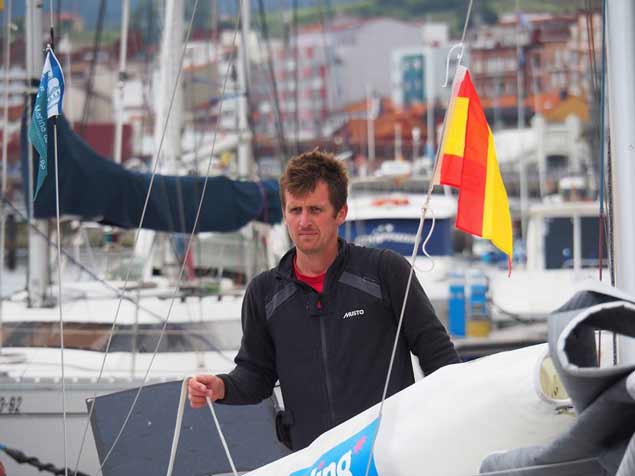 At times, frustration is inevitable. This is Tom coming into Aviles in Spain after seeing a podium place snatched from him in hyper-flukey breezes over the last mile to the finish of a race in July from France.
At times, frustration is inevitable. This is Tom coming into Aviles in Spain after seeing a podium place snatched from him in hyper-flukey breezes over the last mile to the finish of a race in July from France.
That’s only the budget with a standard boat sailed by someone with a very modest expectations of their standard of living. Quite what some of the prototype boats, where the current star is Ian Lipinski with the optimised scow Griffon.fr, might cost scarcely bears thinking about, but we note that one of the best-presented is the Swiss entry raced by Simon Koster, whose “home port” is Zurich, where at least they’re accustomed to thinking in terms of sums of money with a lot of zeroes at the end.
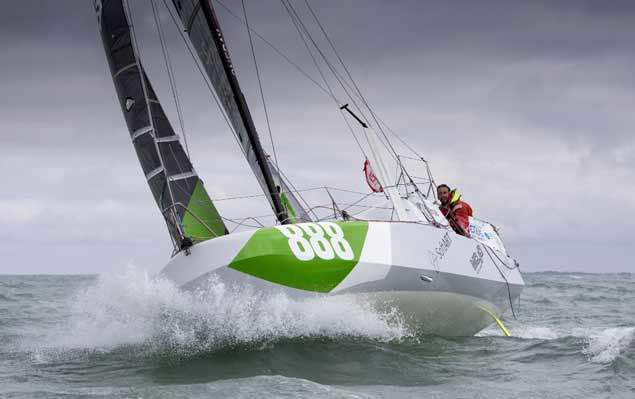 Zurich goes sailing. Simon Koster’s Eight Cube is in the experimental Proto class
Zurich goes sailing. Simon Koster’s Eight Cube is in the experimental Proto class
The mood of Zurich is a million miles from the mood of Meath, yet Tom Dolan has managed to haul himself up the slippery slope to an international outlook, and is currently ranked fourth in the Mini Transat Series Production Division, which makes up much the larger part of tomorrow’s 81-strong fleet.
His aim is a podium place, and he has been on that podium or near it in almost every race this past summer. But now it’s down to the moment of truth tomorrow, to race the 1,350 miles to Gran Canaria, about a week of sailing following which there’s a pause while they wait for the current very vigorous hurricane season to end, and then they race the 2,700 miles Transatlantic miles to Le Marin in Martinique.
The contrast between the rugged racing in the Bay of Biscay and the Atlantic, and today’s carnival atmosphere in La Rochelle, where Irish Sailing President Jack Roy is representing our goodwill towards Tom at a noon reception with the Cultural & Sporting Attache from the Irish Embassy, simply could not be greater. Yet that is part and parcel of the way things are with modern high-profile heavily-sponsored international sailing events.
 Currently topping the Proto rankings is Ian Lipinsky’s Griffon.fr
Currently topping the Proto rankings is Ian Lipinsky’s Griffon.fr
You need to be tough in body and mind to race the Atlantic solo, but by heavens you also need to be tough to survive and even enjoy the huge social buildup beforehand. Talking to Afloat.ie on Thursday, Tom was philosophical but clear in his mind – the waiting is tough, for the boat IRL 910 is as ready as she’ll ever be, and he is simply keyed up to get out there sailing in a fleet of 81 boats from 11 nationalities, with ten women and 61 men.
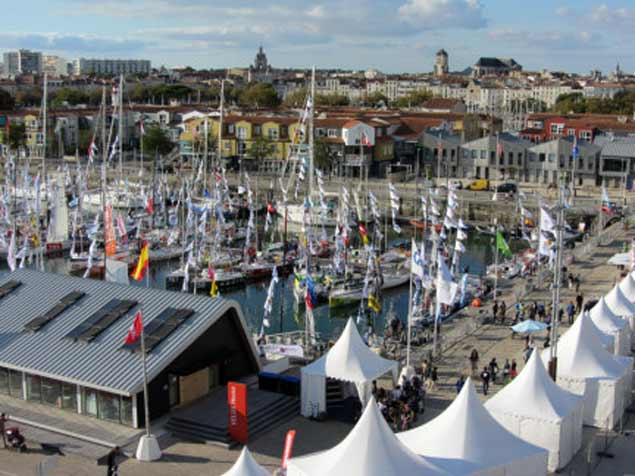 The Mini Transat La Boulangerie Village, where Tom Dolan will be celebrated at an Irish party today
The Mini Transat La Boulangerie Village, where Tom Dolan will be celebrated at an Irish party today
Out there, after a few hours with the spectator fleet now far astern, he knows he’ll be in “the zone”, in total racing mode thinking only of his known top competitors such as Erwan Le Draoulec, Clarisse Cremer, Puerre Chedeville, Henri Patou and Remi Ajburn, to name only five. There must be at least a dozen in the 56-strong production class alone who are in there with a realistic chance. But there’s only one answer as to who they really are. And that answer begins to be given tomorrow.
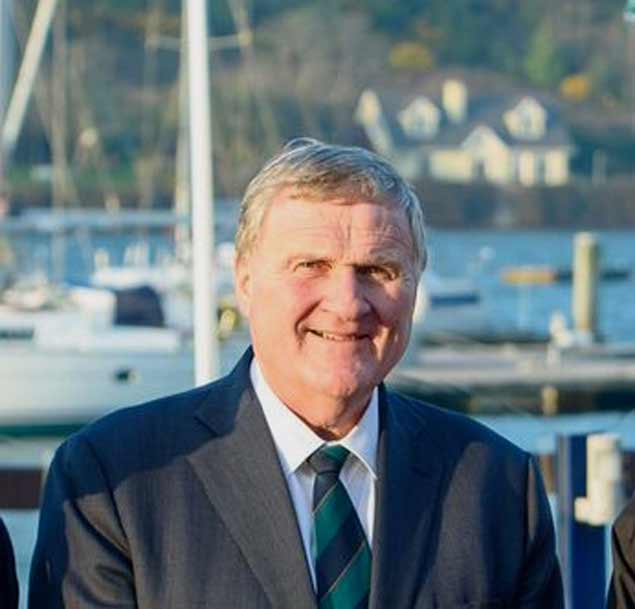 Jack Roy, President Irish Sailing, is in La Rochelle to wish Tom Dolan well, as we all do. Photo Robert Bateman
Jack Roy, President Irish Sailing, is in La Rochelle to wish Tom Dolan well, as we all do. Photo Robert Bateman



























